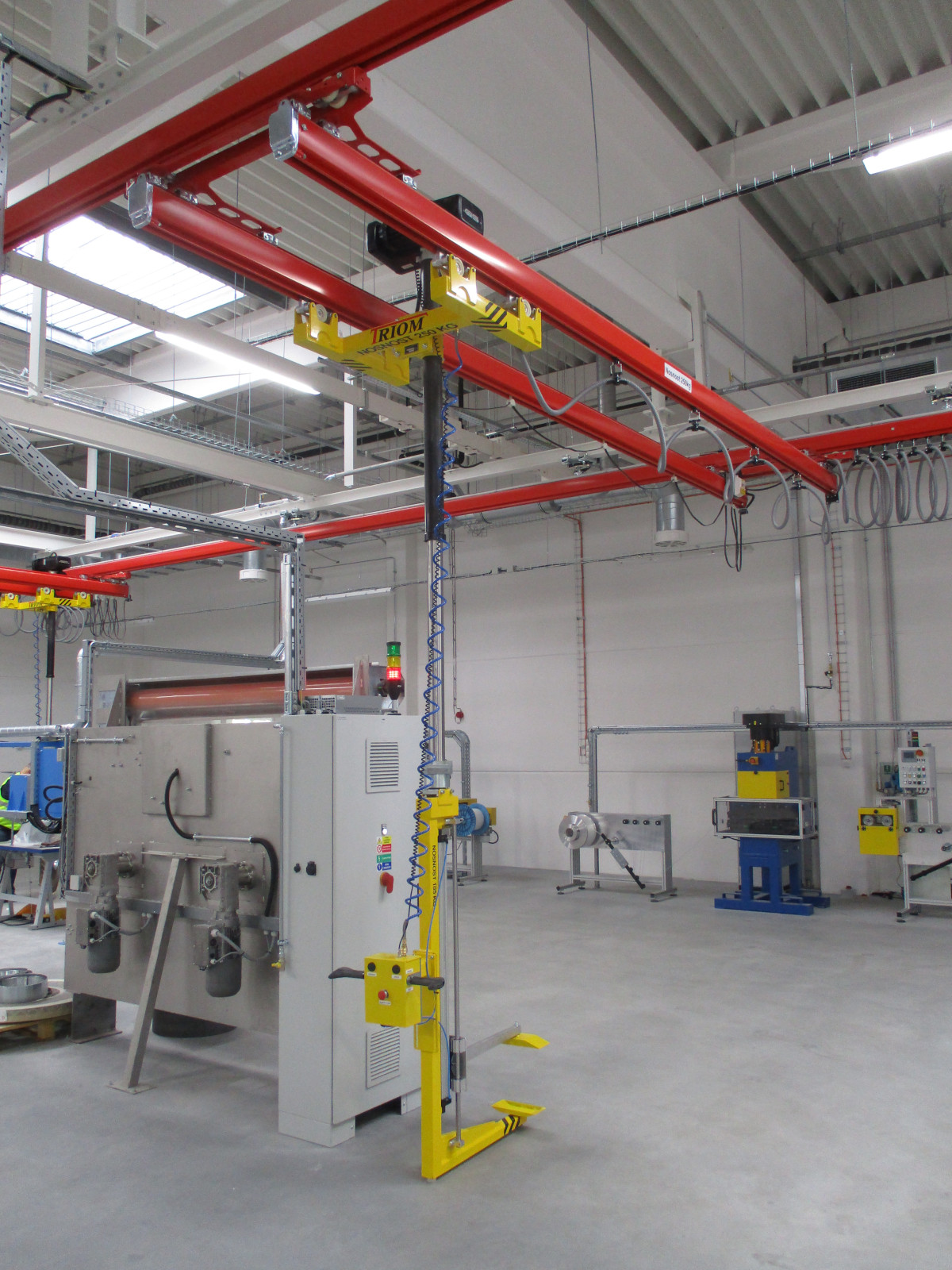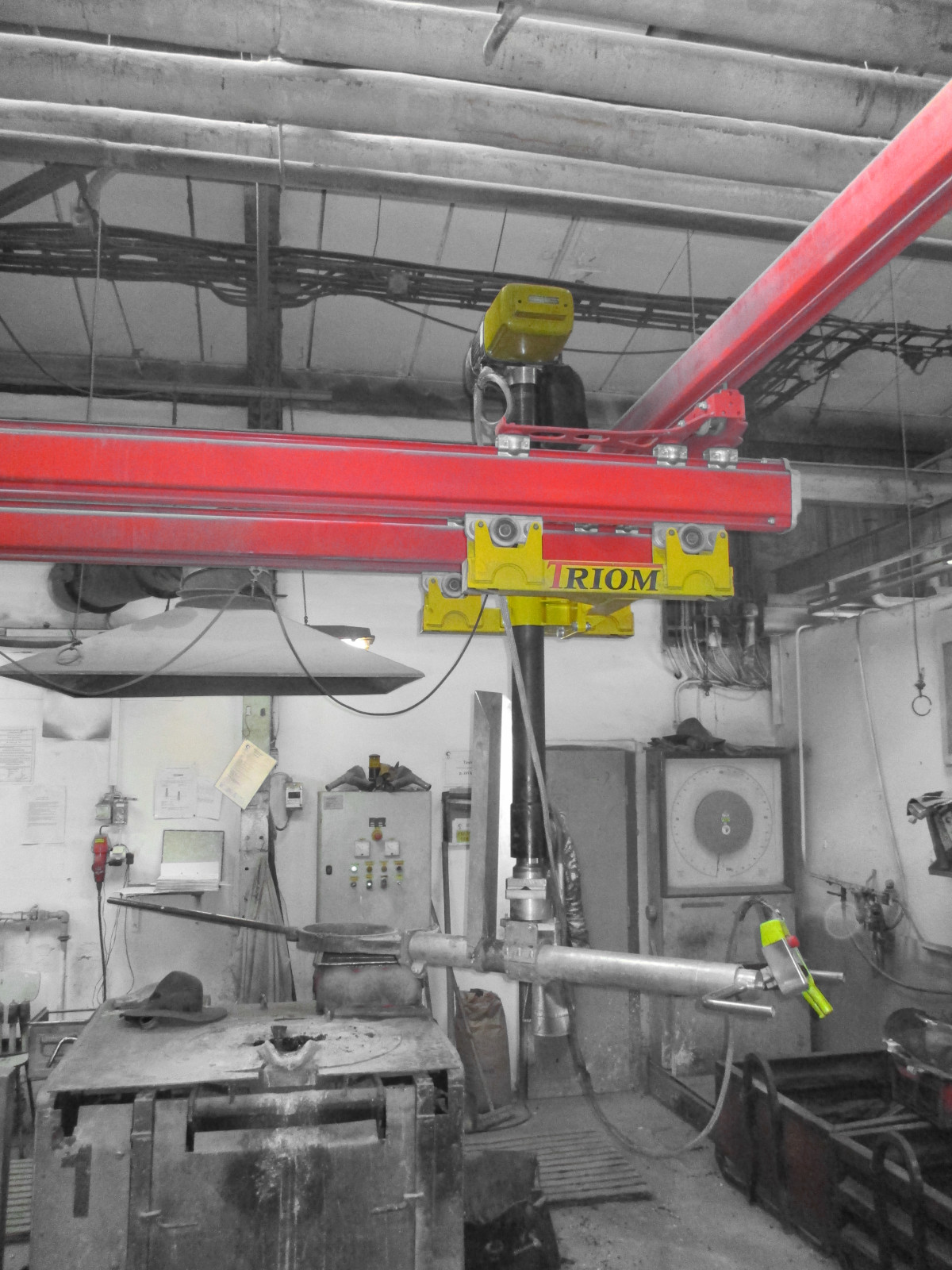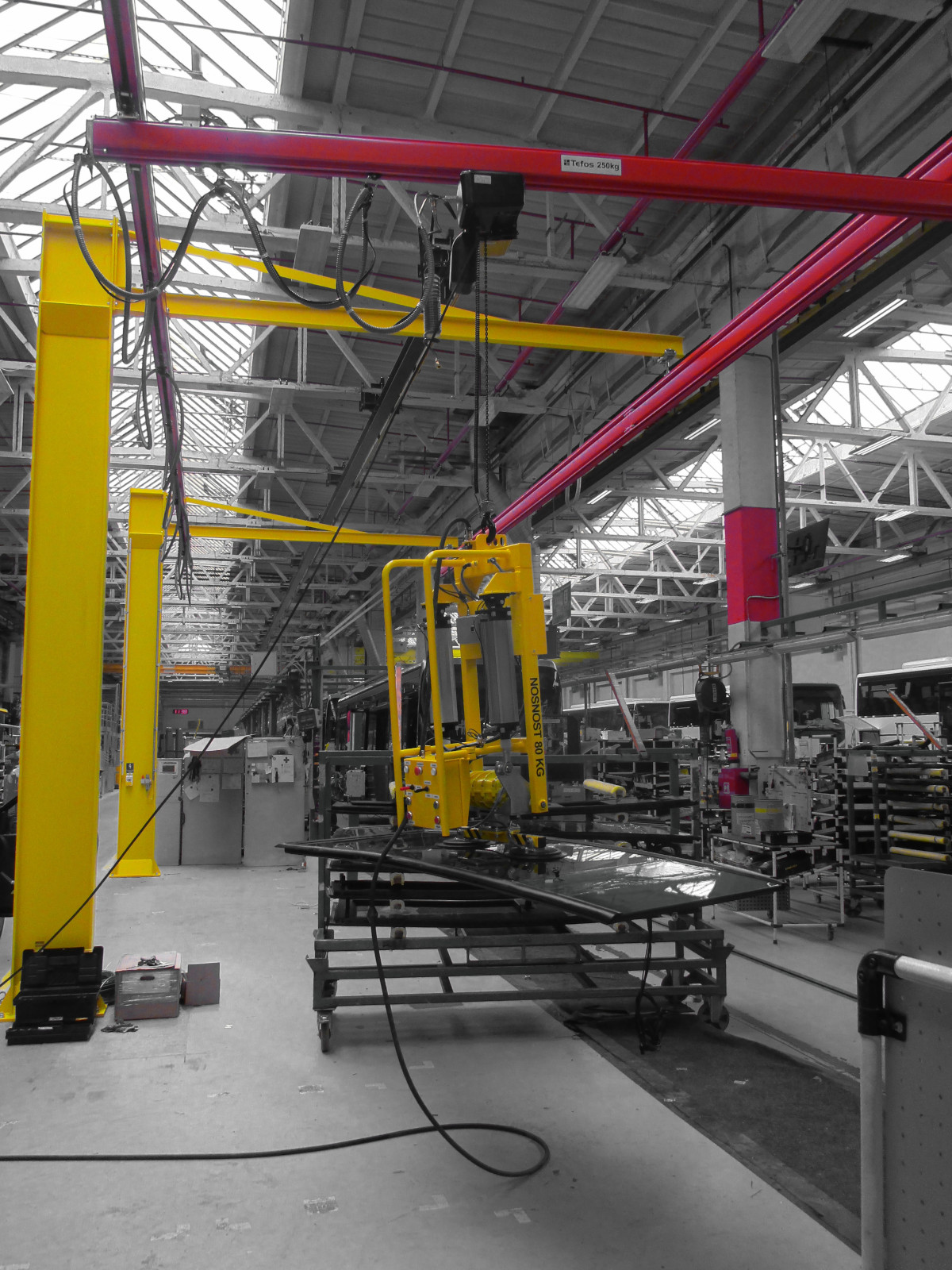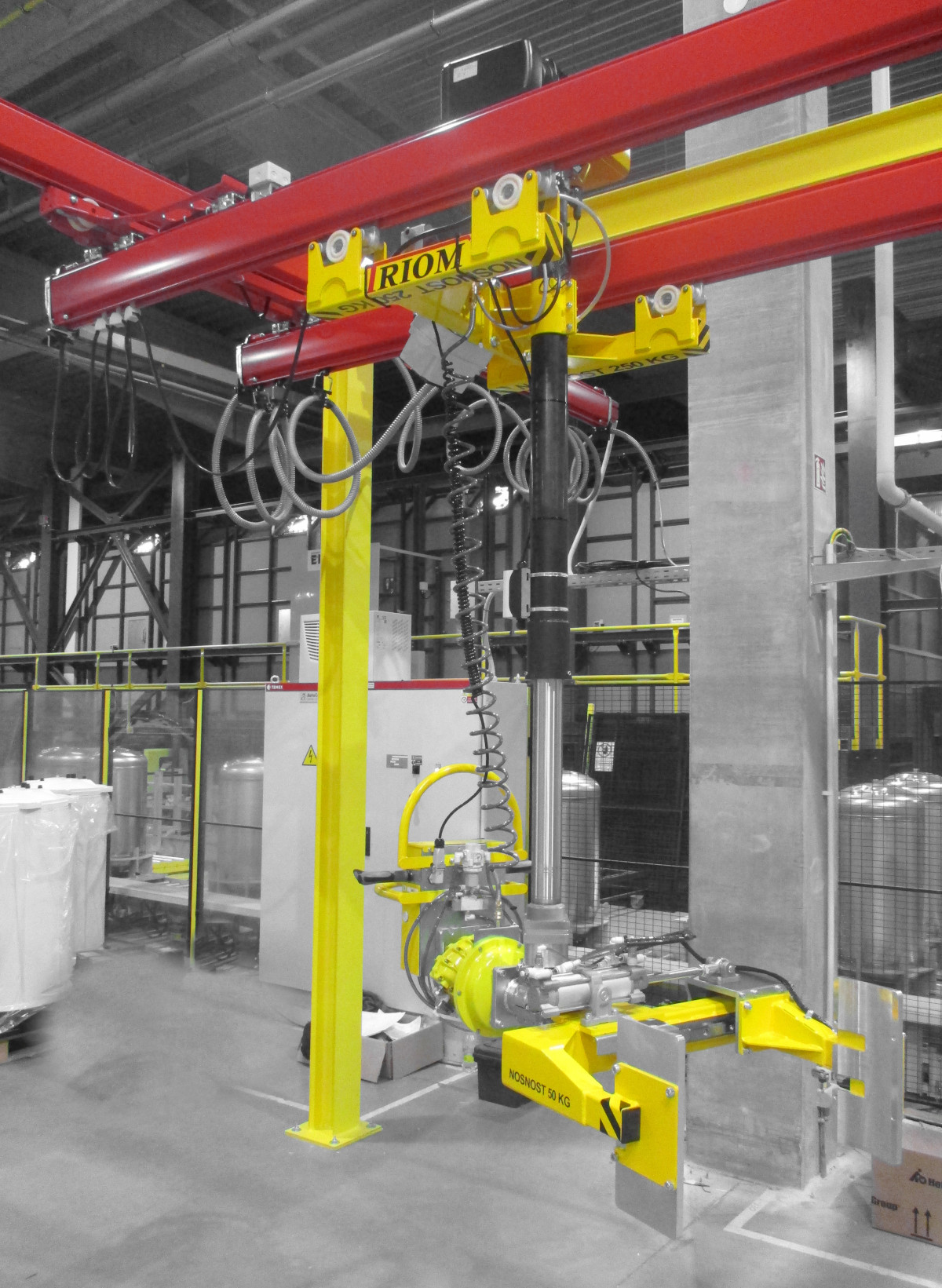30.Jul 2025
Gantry crane vs. Rail-Guided Manipulators
In modern industry, efficient and safe material handling is essential for productivity and smooth operations. Various types of lifting equipment are used to perform these tasks, and we will compare two of them in more detail: gantry cranes and rail-guided manipulators. Although both types are used for moving loads, they differ in design principles, load capacity, advantages, and areas of application.
Rail-Guided Manipulators
Rail-guided manipulators are a type of handling equipment that move along a longitudinal track with a cross bridge, typically above a production line or in a workshop. The most common type is the overhead manipulator, which moves along the rail and has a drive mechanism on top. These manipulators are designed for precise and efficient load handling.

Basic Components of Rail-Guided Manipulators
- Rail Track Permanently installed track on which the manipulator moves. It can be single-girder or double-girder.
- Manipulator The moving part that travels along the rail track.
- Hoisting Unit Allows lifting and lowering of the load.
- Gripper/Clamp/Tool Allows gripping and handling of the load. A wide range of gripping heads exist, including mechanical, vacuum (suction cups), magnetic, and combined types.
- Control System Controls the movement of the manipulator and hoisting unit.
- Safety Features Include fuses, limit switches, and lift limiters to ensure safe operation.

Advantages of Rail-Guided Manipulators
Unlike gantry cranes, rail-guided manipulators are mainly designed for lighter loads and tasks requiring higher precision.
- Higher Positioning Accuracy Ideal for repetitive operations requiring precise load placement.
- Ergonomic Design Reduces operator effort and protects worker health from excessive strain. Also suitable for replacing human labor in hazardous or monotonous tasks.
- Gripper Flexibility Various gripper types (vacuum frames, clamps, tools) make them very flexible for handling different shapes and materials.
- Automation Integration Easily integrated into production lines and automated systems. Allows task programming and process monitoring.
- Compactness and Space Utilization Especially overhead manipulators minimize floor space usage and reduce risk to workers, as they operate from elevated tracks.
- Speed and Dynamics Belt or linear motor drives provide high dynamics and motion reproducibility.
- Eco-Friendliness (Pneumatic Systems) Pneumatic components use air as a working medium, ensuring clean and safe operation without environmental contamination. Unlike hydraulics, they produce no liquid waste and need no special disposal. However, pneumatic systems consume more energy and require regular filter maintenance and condensate drainage.
Where Are They Used?
- Handling Tasks Moving, storing, or sorting products at processing machines and equipment.
- Assembly Tasks Used in assembly where end effectors are equipped with tools and can perform additional axis movements or rotations.
- Automated Processes Used in automated lines, e.g., for material intake and output between storage and handling tables.
- Hazardous Environments Special grippers designed for operations that would endanger human health.

Gantry Cranes
A gantry crane is a type of lifting equipment with a bridge-like structure supported by two vertical legs forming a "gantry". These cranes are designed to move heavy loads across a designated area. They can either be fixed on rails or mobile on wheels. If one leg is replaced by a runway at bridge height, it's called a semi-gantry crane.
The gantry crane structure includes a bridge, two legs, and crossbeams with travel wheels. Drives are usually frequency-controlled, allowing smooth acceleration and braking, reducing sway and ensuring safe handling.
Types of Gantry Cranes:
- Single-Girder Gantry Cranes Have one horizontal beam and are suitable for lighter loads, typically up to 10 tons. Cost-effective and easy to install, ideal for smaller spaces and lower heights.
- Double-Girder Gantry Cranes With two parallel beams for higher strength and stability. Can handle loads of 50+ tons, ideal for large facilities and heavy-duty use. Often equipped with advanced lifting mechanisms.
- Portable and Adjustable Gantry Cranes Offer height and span flexibility. Easily relocated and adapted to various tasks and load sizes.
- Semi-Gantry Cranes Combine fixed and mobile operation, suitable for space-constrained areas.
- Special Types include Rail-Mounted Gantry (RMG) cranes for port container handling and Rubber-Tired Gantry (RTG) cranes, which are mobile on rough terrain and used in intermodal transport.
Advantages of Gantry Cranes
- High Load Capacity Can lift tens to hundreds of tons. Single-girder up to 20 tons, double-girder up to 250+ tons.
- Versatile Usage Suitable for indoor and outdoor areas, used in ports, open storage, transshipment yards, as well as production, warehouse, and assembly halls.
- Flexible Placement Can be installed on rails or as mobile variants moving on floor-mounted wheels.
- Quick Setup and Dismantling Ideal for temporary projects.
- Large Service Area Bridge design provides a wide working range.
- Downtime Minimization Reliable lifting capabilities help reduce interruptions during critical tasks and improve operational flow.
- Enhanced Safety Automated lifting reduces accident risks and allows workers to focus on core tasks. Equipped with overload protection, emergency stop, and other safety features.
- Long-Term Savings High-quality gantry cranes are designed for long life, reducing repair and maintenance costs.
Applications
- Construction and Heavy Industry Essential for lifting and transporting beams, panels, and other heavy components. Useful for material handling on-site, adaptable to terrain. E.g., handling large prefabs.
- Manufacturing Facilities Efficiently move components along assembly lines, handle heavy machinery, and support quality control of large parts.
- Storage and Logistics Simplify loading/unloading of pallets and containers, optimize space, and improve inventory management.
- Special Applications Designed for explosive environments (Ex zones) or vacuum lifting for sensitive materials like ceramic molds. Magnetic cranes exist for ferromagnetic materials.
What Are the Key Differences?
Load Capacity
This is likely the most significant difference. Gantry cranes are primarily intended for extremely heavy and large loads with capacities reaching tens or hundreds of tons. Rail-guided manipulators are typically designed for lighter loads up to about 5 tons, with light variants maxing out at around 500 kg.
Precision and Repeatability
Rail-guided manipulators excel in tasks requiring high positioning accuracy and repeatability. Gantry cranes, while also precise, are mainly built for bulk handling of large loads over wide areas.
Movement and Placement Flexibility
Gantry cranes can either be rail-mounted (covering large indoor or outdoor spaces) or fully mobile without rails using swivel wheels. This allows them to adapt to changing site needs.
Rail-guided manipulators are always tied to a fixed track. While the manipulator moves along it, the system itself is stationary. However, they can cover large indoor areas without occupying floor space.
Structural Design
Gantry cranes have a robust frame with a beam supported by vertical legs, forming a gantry. Rail-guided manipulators are typically overhead and suspended from the upper part of the track, minimizing floor footprint.
Role in Operations
Rail-guided manipulators are usually integrated directly into manufacturing or assembly processes for mostly predefined, repetitive tasks. They can replace human labor in hazardous or monotonous environments.

Gantry cranes are used for basic lifting and transporting of large parts or volumes, where speed and capacity are key. They are essential for moving materials between stages of heavy manufacturing or for loading and unloading.
Conclusion
Choosing the right handling technology is essential for optimizing efficiency, safety, and operational costs. The choice between a gantry crane and a rail-guided manipulator depends on specific needs and facility characteristics. In general, gantry cranes are the "workhorses" for heavy-duty and bulk transport, while rail-guided manipulators serve for finer, more precise tasks within complex manufacturing processes.

